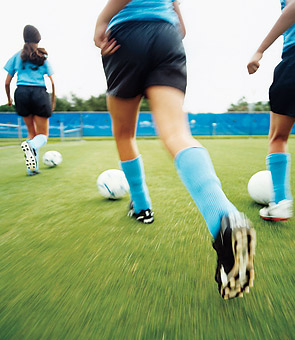
Girls dribbling soccer balls
As a father of two little girls, I sometimes get to spend my weekend afternoons watching my elder daughter run around on the playground, chasing after the other kids, giggling and screaming. She's only 2 1/2, but my wife and I have already agreed that we will encourage the girls to be as physically active as possible in their lives, including signing them up for group sports.
It's likely that athletics will be part of their childhoods and those of their friends, at least early on. Record numbers of girls are now taking part in organized sports — 1 in 3, according to a new report compiled by the Tucker Center for Research on Girls and Women in Sport at the University of Minnesota. That's up from 1 in 27 girls back in 1972, the year that Title IX mandated equal access for both genders in school sports programs.
But there's a downside. Although girls' participation in organized sports is on the rise, the number of girls staying physically active outside this arena is declining, especially after they become teenagers. According to the report, adolescent girls are only half as likely as teen boys to be physically active. That's a big problem. Not only are they forgoing the positive benefits that exercise has for their bodies — better heart health, lower incidence of Type 2 diabetes and prevention of osteoporosis — but they are also missing out on the psychological pluses: compared with their more active counterparts, physically inactive girls rank lower in self-esteem, social skills and the ability to make friends and to handle conflicts.
Both boys and girls face barriers to being physically active, but for girls the challenges are more numerous and complex. Many girls feel as though physical activity is less important for them than it is for boys, a message often echoed by parents, teachers and communities. Girls also report feeling less physically competent in sports than boys.
Opportunity is an issue too. The number of schools offering physical education has dropped over the years, and there is no national mandate requiring schools to build it into their curriculums. Even when P.E. is offered, only about half (48%) of all high school girls are enrolled in the class. The numbers start off promising — 70% of freshman girls enroll — but quickly tail off: only 32% stick around by senior year, according to a 2005 report by the Centers for Disease Control and Prevention. "We're just not teaching kids how to be physically active," says Nicole LaVoi, one of the authors of the Tucker Center report.
Also at fault is what LaVoi refers to as "the professionalization of youth sports" — parents treating kids like mini-pros by pushing them to engage in highly competitive sports leagues. "You could argue that kids just don't know how to participate in unstructured play because there is so much focus on organized activities these days," she says.
Turning these trends around begins with me — and perhaps more important, with my wife. The biggest parts that parents play are making it clear that kids are expected to be active, and acting as good role models themselves. That shapes the entire family's perceptions about the value of fitness.
Parents can also help find activities that are fun for girls, which may not always mean organized competitive sports. Rebekah Granquist, director of program development at the YMCA of San Diego County, the second largest YMCA in the country, says, "Although many girls gravitate toward soccer, volleyball and cheering, more and more girls are signing up for our noncompetitive activities like dance and mind-body programs like yoga." Fit daughters who say om — that'll soothe any mom.
Sanjay Gupta's Fit Nation series airs on House Call on CNN, Saturdays and Sundays, at 8:30 a.m. E.T.
With reporting by Shahreen Abedin / New York